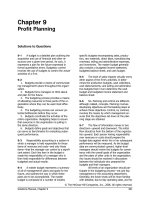Kendall7E ch09
Bạn đang xem bản rút gọn của tài liệu. Xem và tải ngay bản đầy đủ của tài liệu tại đây (713.09 KB, 46 trang )
Describing Process
Specifications
and Structured
Decisions
Systems Analysis and Design,
7e
Kendall & Kendall
© 2008 Pearson Prentice Hall
9
Learning Objectives
• Understand the purpose of process
specifications
• Recognize the difference between
structured and semistructured decisions
• Use structured English, decision tables,
and decision trees to analyze, describe,
and document structured decisions
• Choose an appropriate decision analysis
method for analyzing structured
decisions and creating process
specifications
Kendall & Kendall
9-2
Logic of Decisions
• Documenting and analyzing logic:
• Structured English
• Decision tables
• Decision trees
• Logic and structured decisions are
distinguishable from semistructured
decisions
• Structured decision analysis methods
promote completeness, accuracy, and
communication
Kendall & Kendall
9-3
Major Topics
• Process specifications
• Business rules
• Structured English
• Decision tables
• Decision trees
• Horizontal balancing
Kendall & Kendall
9-4
Process Specifications
• Sometimes called minispecs
• Created for primitive processes as
well as for some higher level
processes on a data flow diagram
• Created for class methods in
object-oriented design and for the
steps in a use case
Kendall & Kendall
9-5
Goals of Producing Process
Specifications
• Reduce process ambiguity
• Obtain a precise description of
what is accomplished
• Validate the system design
Kendall & Kendall
9-6
Process Specifications Are
Not Created
• Processes that represent physical
input and/or output
• Processes that represent simple
data validation
• Processes that use prewritten code
Kendall & Kendall
9-7
Figure 9.1 How process
specifications relate to the data flow
diagram
Kendall & Kendall
9-8
Process Specification
Format Information
•
•
•
•
•
•
•
•
•
•
The process number
The process name
Description of what the process accomplishes
A list of input data flow
Output data flows
Type of process
Uses prewritten code
Process logic description
Logic method reference
List any unresolved issues
Kendall & Kendall
9-9
The Process Number
• Must match the process ID on the
data flow diagram
• Allows the analyst to work on or
review any process, and to locate
the data flow diagram containing
the process easily
Kendall & Kendall
9-10
The Process Name
• The same as displays within the
process symbol on the DFD
Kendall & Kendall
9-11
Description of What the
Process Accomplishes
• Example:
Determine if an item is available for
sale. If it is not available, create a
backordered item record. Determine
the quantity available
Kendall & Kendall
9-12
List of Input Data Flow
• Uses the names found on the data
flow diagram
• Data names used in the formulae
or logic should match the data
dictionary, for consistency and
good communication
Kendall & Kendall
9-13
Output Data Flows
• Uses data flow diagram and data
dictionary names
Kendall & Kendall
9-14
Type of Process
• Batch
• Online
• Require screen designs
• Manual
• Should have well-defined procedures
for employees performing the process
tasks
Kendall & Kendall
9-15
Uses Prewritten Code
• Include the name of the
subprogram or function containing
the code
Kendall & Kendall
9-16
Process Logic Description
• This should state policy and
business rules, not computer
language pseudocode
• Business rules are the procedures
that allow a corporation to run its
business
Kendall & Kendall
9-17
Common Business Rule
Formats
• Definitions of business terms
• Business conditions and actions
• Data integrity constraints
• Mathematical and functional derivations
• Logical inferences
• Processing sequences
• Relationships among facts about the
business
Kendall & Kendall
9-18
Logic Method Reference
• If there is not enough room for a
complete structured English
description include a reference to
the structured English description,
decision table, or tree depicting
the logic
Kendall & Kendall
9-19
List Any Unresolved Issues
• Incomplete portions of logic
• These issues form the basis of the
questions used for follow-up
interviews with users or business
experts you have added to your
project team
Kendall & Kendall
9-20









